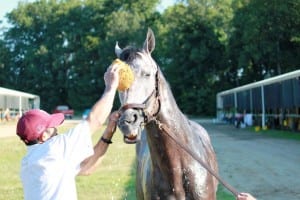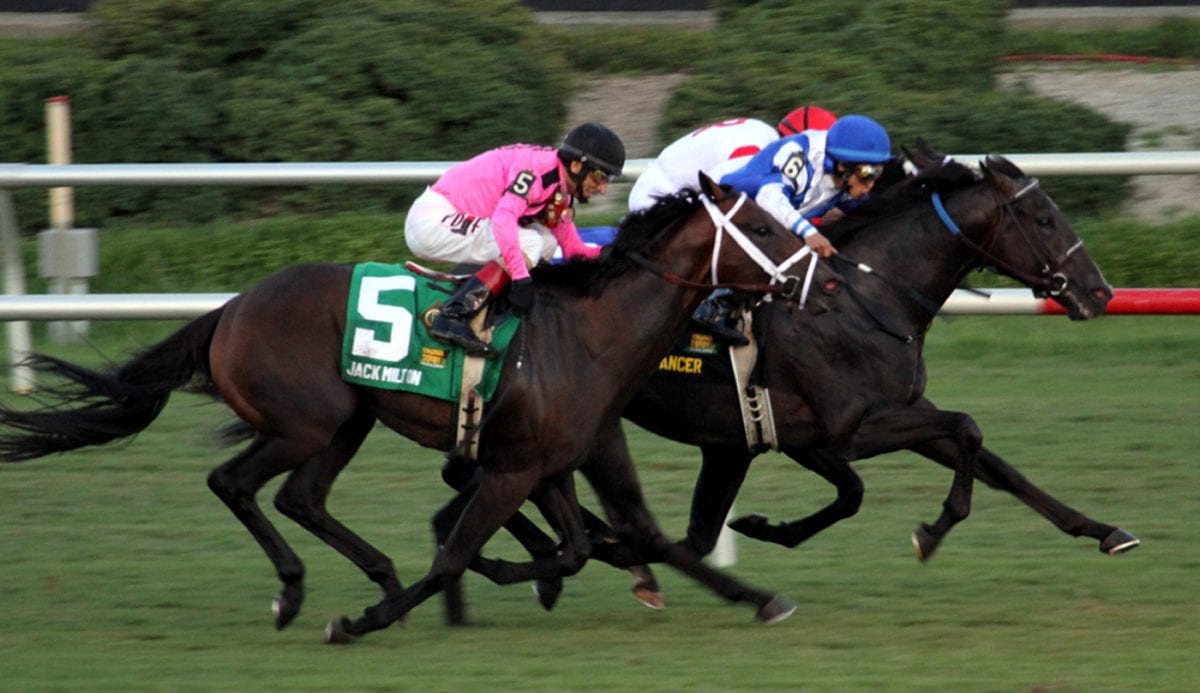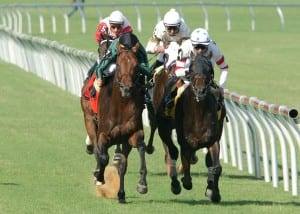
Paddy O’Prado, here getting a bath, liked Colonial so much he stayed for a while and won two races. Photo by Nick Hahn.
by Nick Hahn
For a decade, the Virginia Derby at Colonial Downs has owned the first half of the sophomore turf season, carving a niche for itself, along with Arlington’s Secretariat Stakes, as the signature three year-old turf races in the United States.
Its winners are impressive enough that making a short list is challenging, its defeated challengers numerous and worthy. Yet with the New York Racing Association’s announcement earlier that the $300,000 Jamaica Handicap for three year-olds would henceforward be the $1.25 million Belmont Derby Invitational — and that it would be run on July 5th — the Virginia Derby’s privileged position is getting the squeeze.
When the Virginia Derby was first run for $1 million in 2006, it boasted a purse four times the amount of any other three year-old turf stakes run before it each year. Two months after the Run for the Roses and a month after the Belmont Stakes, it sat perfectly in the calendar, usually attracting several Triple Crown refugees with instant name recognition, many of them Kentucky Derby starters.
With the Belmont Derby now slated two weeks before the Virginia Derby’s traditional mid-July running date, Colonial’s race goes from focus to alternative.
Virginia Derby winners and top performers usually left the home state of Big Red — and the Colonial turf course named in his honor — for the stakes race named for him, the $400,000 Secretariat Stakes (GI). Run the following month at Arlington Park, the Secretariat’s post parade had the silks of many Virginia Derby winners and starters, allowing the footprint of Colonial’s meet to extend into late summer.
First run in 1998 when the Virginia track was racing in the fall, the signature race of Colonial Downs quickly grabbed national attention when racing switched to the summer and then had its purse more than doubled to $500,000. Jonathan Sheppard won two of the first four editions of the Virginia Derby with Crowd Pleaser and Potaro (IRE).
After Kitten’s Joy launched his successful career with a Virginia Derby win in what Ken Ramsey still calls the best race of his career, owner Jeffery Jacobs created the $5 million Grand Slam of Grass. The four-race bonus series included two Colonial races, the Breeders’ Cup Turf, and the Secretariat Stakes — unbeknownst to Arlington Park officials on the day of its announcement. Jacob’s challenge added a Virginia Derby twin, the Colonial Turf Cup to, the Colonial calendar, a half-furlong shorter than the mile-and-a-quarter Derby. Such was the void in the three year-old turf division in North America, and Colonial filled it.
For whatever reasons, no track operators really countered Colonial’s hold on the division, and for the rural track, it was beautiful.
Good horses generated great races, creating colorful stories, from Chicken Soup for the Soul mastermind Peter Vegso’s three trips to the winner’s circle to the extended visits of equine stars like Paddy O’Prado and Battle of Hastings. There was even brief — though not really serious — consideration of expanding the field to 20.
Meantime, however, clouds were starting to gather. Even when out-of-state interest was peaking, the track struggled for purchase in the Commonwealth, its biggest race often run in Tidewater’s humidity, rain or even at night in recent years. And, of course, the arrival of slot machine gambling virtually everywhere but Virginia left Colonial laboring to offer competitive purses. In 2008, the Derby purse dipped back below $1 million, and by last year it had fallen to $500,000.
In 2010, racing officials opened the Colonial Turf Cup to older horses and failed to offer a substitute for an in-meet prep race left in its gap. Last year, Penn National introduced the $500,000 Penn Mile — the same purse level as the Virginia Derby. Although the top three performers in the Penn Mile entered the Virginia Derby starting gate, Colonial’s hold on the three year-old turf division was beginning to weaken.
And now comes the Belmont Derby. With so many good horses based in New York, and offering the largest purse available to turfing sophomores, that race figures to get first call on the division. It will be difficult to lure the best down south.
It’s remarkable that it has taken so long for other track operators to muscle in on what had been Virginia’s prize. But the lack of racing resources in Virginia has made it difficult to maintain that niche. In recent years, trainers based in New York endured the overnight shuttle to Virginia for lucrative Virginia Derby purses.
With the steady decline of its purse level, the Virginia Derby will revert to the stature it held in its formative years — a nice race, but not a necessity. Indeed, that Colonial’s 2014 meet itself is in question further tarnishes the race’s brand. It may still attract good horses, but not as it has in years past.
For many of us that have watched the Virginia Derby in Colonial’s grandstand or along the rail, in future years we may look back at the Virginia Derby of recent vintage and realize how good we had it.
(Featured image, of War Dancer winning the 2013 Virginia Derby, by Laurie Asseo.)









